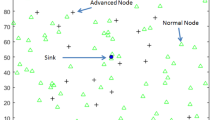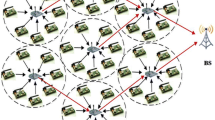Abstract
Clustering is one of the most famous open problems of wireless sensor network (WSN) that has been studied for years because all the sensors in a WSN have only a limited amount of energy. As such, the so-called low-energy adaptive clustering hierarchy (LEACH) was presented to prolong the lifetime of a WSN. Although the original idea of LEACH is to keep each sensor in a WSN from being chosen as a cluster head (CH) too frequently so that the loading of the sensors will be balanced, thus avoiding particular sensors from running out of their energy quickly and particular regions from failing to work, it is far from perfect because LEACH may select an unsuitable set of sensors as the cluster heads. In this paper, a high-performance hyper-heuristic algorithm will be presented to enhance the clustering results of WSN called hyper-heuristic clustering algorithm (HHCA). The proposed algorithm is designed to reduce the energy consumption of a WSN, by using a high-performance metaheuristic algorithm to find a better solution to balance the residual energy of all the sensors so that the number of alive sensor nodes will be maximized. To evaluate the performance of the proposed algorithm, it is compared with LEACH, LEACH with genetic algorithm, and hyper-heuristic algorithm alone in this study. Experimental results show that HHCA is able to provide a better result than all the other clustering algorithms compared in this paper, in terms of the energy consumed.










Similar content being viewed by others
Notes
Compared to the exhaustive search algorithm, metaheuristics is fast because it does not check all the candidate solutions.
References
Potdar V, Sharif A, Chang E (2009) Wireless sensor networks: A survey Proceedings of the international conference on advanced information networking and applications workshops, pp 636–641
Sang Y, Shen H, Inoguchi Y, Tan Y, Xiong N (2006) Secure data aggregation in wireless sensor networks: A survey Proceedings of the 7th international conference on parallel and distributed computing, applications and technologies, pp 315–320
Losilla F, Garcia-Sanchez AJ, Garcia-Sanchez F, Garcia-Haro J, Haas ZJ (2011) A comprehensive approach to WSN-based ITS applications: A survey. Sensors 11(11):10,220–10,265
Harrop P, Das R (2015) Wireless sensor networks (WSN) 2014–2024: Forecasts, technologies, players. [Online]. Available: http://www.idtechex.com/research/reports/wireless-sensor-networks-wsn-2014-2024-forecasts-technologies-players-000382.asp
IDC (2014) The internet of things: Data from embedded systems will account for 10% of the digital universe by 2020. [Online]. Available: https://www.emc.com/leadership/digital-universe/2014iview/internet-of-things.htm
Reese L (2015) Industrial wireless sensor networks. [Online]. Available: http://www.mouser.com/applications/rf-sensor-networks/
Tsai CW, Hong TP, Shiu GN (2016) Metaheuristics for the lifetime of WSN: A review. IEEE Sensors J 16(9):2812–2831
Heinzelman WR, Chandrakasan A, Balakrishnan H (2000) Energy-efficient communication protocol for wireless microsensor networks Proceedings of annual Hawaii international conference on system sciences, pp 1–10
Hoang D, Yadav P, Kumar R, Panda S (2010) A robust harmony search algorithm based clustering protocol for wireless sensor networks Proceedings of IEEE international conference on communications workshops, pp 1–5
Blum C, Roli A (2003) Metaheuristics in combinatorial optimization: Overview and conceptual comparison. ACM Comput Surv 35(3):268–308
Kulkarni RV, Venayagamoorthy GK (2011) Particle swarm optimization in wireless-sensor networks: A brief survey. IEEE Trans Syst Man Cybern Part C Appl Rev 41(2):262–267
Heinzelman WR, Chandrakasan A, Balakrishnan H (2000) Energy-efficient communication protocol for wireless microsensor networks Proceedings of the Hawaii international conference on system sciences
Latiff N, Tsimenidis C, Sharif B (2007) Energy-aware clustering for wireless sensor networks using particle swarm optimization Proceedings of the IEEE international symposium on personal, indoor and mobile radio communications , pp 1–5
Khanna R, Liu H, Chen HH (2006) Self-organisation of sensor networks using genetic algorithms. Int J Sensor Netw 1(3/4):241–252
Peiravi A, Mashhadi HR, Hamed Javadi S (2013) An optimal energy-efficient clustering method in wireless sensor networks using multi-objective genetic algorithm. Int J Commun Syst 26(1):114–126
Lee D, Lee W, Kim J (2007) Genetic algorithmic topology control for two-tiered wireless sensor networks Proceedings of the international conference on computational science, pp 385– 392
Seo HS, Oh SJ, Lee CW (2009) Evolutionary genetic algorithm for efficient clustering of wireless sensor networks Proceedings of the IEEE conference on consumer communications and networking conference, pp 258–262
Agarwal T, Kumar D, Prakash N (2010) Prolonging network lifetime using ant colony optimization algorithm on LEACH protocol for wireless sensor networks Proceedings of the recent trends in networks and communications, pp 634–641
Singh B, Lobiyal D (2012) A novel energy-aware cluster head selection based on particle swarm optimization for wireless sensor networks. Human-Centric Comp Info Sci 2(1):1–18
Siew ZW, Wong CH, Chin CS, Kiring A, Teo K (2012) Cluster heads distribution of wireless sensor networks via adaptive particle swarm optimization Proceedings of the international conference on computational intelligence, communication systems and networks, pp 78–83
Abdul Latiff N, Tsimenidis C, Sharif B, Ladha C (2008) Dynamic clustering using binary multi-objective particle swarm optimization for wireless sensor networks Proceedings of the IEEE international symposium on personal, indoor and mobile radio communications, pp 1–5
Zhang J, Lin Y, Zhou C, Ouyang J (2008) Optimal model for energy-efficient clustering in wireless sensor networks using global simulated annealing genetic algorithm Proceedings of the international symposium on intelligent information technology application workshops, pp 656–660
Cowling P, Kendall G, Soubeiga E (2001) A hyperheuristic approach to scheduling a sales summit Proceedings of practice and theory of automated timetabling III, pp 176–190
Tsai CW, Huang WC, Chiang MH, Chiang MC, Yang CS (2014) A hyper-heuristic scheduling algorithm for cloud. IEEE Trans Cloud Comp 2(2):236–250
Tsai CW, Chang WL, Hu KC, Chiang MC (2016) An effective hyper-heuristic algorithm for clustering problem of wireless sensor network Proceedings of the EAI international conference on heterogeneous networking for quality, reliability, security and robustness, pp 1–12
Heinzelman WB, Chandrakasan AP, Balakrishnan H (2002) An application-specific protocol architecture for wireless microsensor networks. IEEE Trans Wirel Commun 1(4):660–670
Alba E (2005) Parallel metaheuristics: a new class of algorithms. Wiley-Interscience
Liu JL, Ravishankar CV (2011) LEACH-GA: Genetic Algorithm-based energy-efficient adaptive clustering protocol for wireless sensor networks. Int J Machine Learn Comp 1(1):79–85
Acknowledgments
The authors would like to thank the anonymous reviewers for their valuable comments and suggestions on the paper. This work was supported in part by the Ministry of Science and Technology of Taiwan, R.O.C., under Contracts MOST104-2221-E-197-005, MOST105-2221-E-197-015, MOST104-2221-E-110-014, and MOST105-2221-E-110-067.
Author information
Authors and Affiliations
Corresponding author
Rights and permissions
About this article
Cite this article
Tsai, CW., Chang, WL., Hu, KC. et al. An Improved Hyper-Heuristic Clustering Algorithm for Wireless Sensor Networks. Mobile Netw Appl 22, 943–958 (2017). https://doi.org/10.1007/s11036-017-0854-5
Published:
Issue Date:
DOI: https://doi.org/10.1007/s11036-017-0854-5




